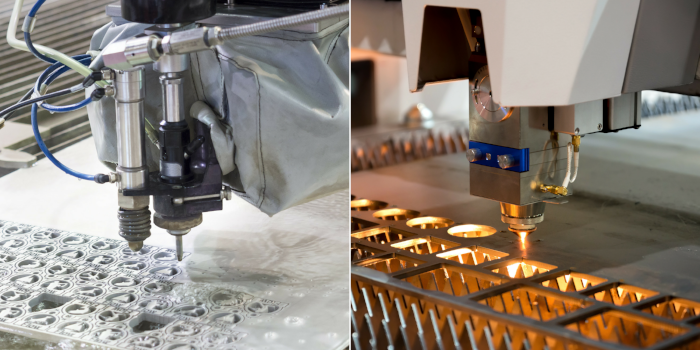Choosing between laser and waterjet cutting is not as straightforward as it may seem. It’s not possible to say which one is better, as each can be more suitable for different materials and applications. Choosing between laser and waterjet cutting would, therefore, entirely depend on your specifications.
To begin deciding which technique would work better for you there are a number of questions that you would need to ask yourself, such as:
- What type of material do you want to cut?
- What is its thickness?
- What tolerance and edge finish are required?
- Does it matter if heat affects your part?
In this blog, we examine the two methods and compare their capabilities.
Laser cutting involves the use of a laser to melt, burn, or vaporize material. During the process, a focused beam of light is used for the cut. The laser can be static or move across the material. Laser cutters do well with materials that range between 0.12” and 0.4” in thickness, and are commonly used to cut flat sheets of medium thickness steel.
Waterjet uses a cutting jet of pressurised water, which is often mixed with an abrasive, such as garnet. The technique enables the cut of a wider range of materials, cleanly, to close tolerances, squarely and with a good edge finish.
Although laser cutting is often seen as a complementary service to waterjet cutting, the latter does have a number of advantages, including:
- Can work with more materials
- Can cut materials thickness that is difficult or impossible to be cut with laser
- No heat-affected zone (HAZ)
- More environmentally friendly
- Much safer
- Uniformity of material is not important
- Better tolerance on thicker parts
- Better edge finish
While laser can cut non-ferrous materials, these tend to be quite thin, such as plastics and wood. However, the edge would be burnt due to heat generation of the method. With waterjet cutting, on the other hand, you could profile virtually any material up to 250mm thickness, with very few exceptions, compared to laser’s 25mm thickness. When looking at capabilities, waterjet cutting can cover tolerances as close as ±003”, while laser tolerances as close as ±002”.
Part features also play part in choosing between the two methods. Holes smaller in diameter that the thickness of the material cannot be lasered, however, holes extremely small can be cut on a waterjet. Material flatness may be another point of interest in that thin materials may be warped by the laser process but waterjet can cut materials as thin as 0.001” with no issues.
What is the cost?
A lot of people that are not bothered about quality of finish or accuracy often go for laser cutting, as it is no doubt the cheapest option for thin parts, however, with multi heads and the ability to stack up sheets, waterjet cutting is catching up and one very important factor to consider is that as thickness of material increases waterjet becomes more and more cost efficient.
Find out everything you need to know about waterjet cutting and see how the method compares to four other cutting techniques in our free to download eBook, ‘An engineer’s guide to waterjet cutting’.

